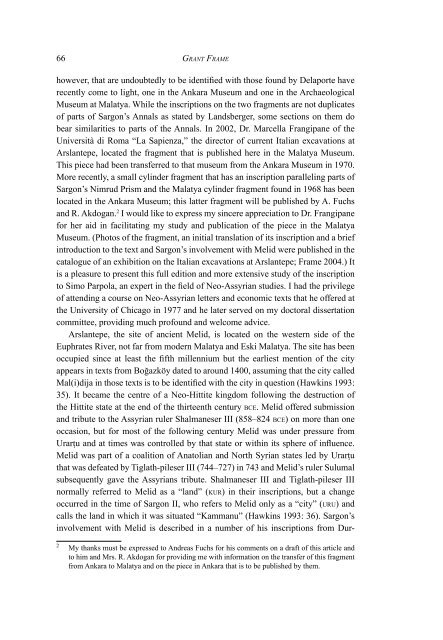Of GOd(s), Trees, KinGs, and schOlars - University College London
Of GOd(s), Trees, KinGs, and schOlars - University College London
Of GOd(s), Trees, KinGs, and schOlars - University College London
- TAGS
- kings
- scholars
- www.ucl.ac.uk
You also want an ePaper? Increase the reach of your titles
YUMPU automatically turns print PDFs into web optimized ePapers that Google loves.
66 Gr a n t Fr a m e<br />
however, that are undoubtedly to be identified with those found by Delaporte have<br />
recently come to light, one in the Ankara Museum <strong>and</strong> one in the Archaeological<br />
Museum at Malatya. While the inscriptions on the two fragments are not duplicates<br />
of parts of Sargon’s Annals as stated by L<strong>and</strong>sberger, some sections on them do<br />
bear similarities to parts of the Annals. In 2002, Dr. Marcella Frangipane of the<br />
Università di Roma “La Sapienza,” the director of current Italian excavations at<br />
Arslantepe, located the fragment that is published here in the Malatya Museum.<br />
This piece had been transferred to that museum from the Ankara Museum in 1970.<br />
More recently, a small cylinder fragment that has an inscription paralleling parts of<br />
Sargon’s Nimrud Prism <strong>and</strong> the Malatya cylinder fragment found in 1968 has been<br />
located in the Ankara Museum; this latter fragment will be published by A. Fuchs<br />
<strong>and</strong> R. Akdogan. 2 I would like to express my sincere appreciation to Dr. Frangipane<br />
for her aid in facilitating my study <strong>and</strong> publication of the piece in the Malatya<br />
Museum. (Photos of the fragment, an initial translation of its inscription <strong>and</strong> a brief<br />
introduction to the text <strong>and</strong> Sargon’s involvement with Melid were published in the<br />
catalogue of an exhibition on the Italian excavations at Arslantepe; Frame 2004.) It<br />
is a pleasure to present this full edition <strong>and</strong> more extensive study of the inscription<br />
to Simo Parpola, an expert in the field of Neo-Assyrian studies. I had the privilege<br />
of attending a course on Neo-Assyrian letters <strong>and</strong> economic texts that he offered at<br />
the <strong>University</strong> of Chicago in 1977 <strong>and</strong> he later served on my doctoral dissertation<br />
committee, providing much profound <strong>and</strong> welcome advice.<br />
Arslantepe, the site of ancient Melid, is located on the western side of the<br />
Euphrates River, not far from modern Malatya <strong>and</strong> Eski Malatya. The site has been<br />
occupied since at least the fifth millennium but the earliest mention of the city<br />
appears in texts from Boğazköy dated to around 1400, assuming that the city called<br />
Mal(i)dija in those texts is to be identified with the city in question (Hawkins 1993:<br />
35). It became the centre of a Neo-Hittite kingdom following the destruction of<br />
the Hittite state at the end of the thirteenth century b c e. Melid offered submission<br />
<strong>and</strong> tribute to the Assyrian ruler Shalmaneser III (858–824 b c e) on more than one<br />
occasion, but for most of the following century Melid was under pressure from<br />
Urarṭu <strong>and</strong> at times was controlled by that state or within its sphere of influence.<br />
Melid was part of a coalition of Anatolian <strong>and</strong> North Syrian states led by Urarṭu<br />
that was defeated by Tiglath-pileser III (744–727) in 743 <strong>and</strong> Melid’s ruler Sulumal<br />
subsequently gave the Assyrians tribute. Shalmaneser III <strong>and</strong> Tiglath-pileser III<br />
normally referred to Melid as a “l<strong>and</strong>” (k u r) in their inscriptions, but a change<br />
occurred in the time of Sargon II, who refers to Melid only as a “city” (u r u) <strong>and</strong><br />
calls the l<strong>and</strong> in which it was situated “Kammanu” (Hawkins 1993: 36). Sargon’s<br />
involvement with Melid is described in a number of his inscriptions from Dur-<br />
2 My thanks must be expressed to Andreas Fuchs for his comments on a draft of this article <strong>and</strong><br />
to him <strong>and</strong> Mrs. R. Akdogan for providing me with information on the transfer of this fragment<br />
from Ankara to Malatya <strong>and</strong> on the piece in Ankara that is to be published by them.

















